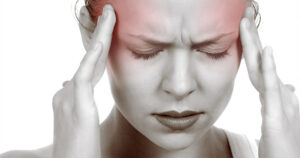
MIGRAINE PAIN
Migraine Pain
Migraine pain is different from tension headaches. They are the most common neurological disorder, affecting approximately 14% of the adult population. 75% of migraine suffers are women, although men and children can be affected too. They are most prevalent between the ages of 15 to 55 and less severe after 50 years of age. Migraine symptoms vary from person to person and an individual can experience different symptoms from one episode to the next. In the majority of cases, migraine sufferers will postpone work, school and other commitments until the migraine resolves.
Migraine can be disabling and the symptoms may present as:
- Sensory or visual disturbance.
- Visual and sensory changes.
- Nausea and vomiting.
- Light and sound hypersensitivity.
- Difficulty thinking and a “foggy” head.
- Balance and hearing problems.
- Pain in specific regions the head, face and neck.
Migraines generally develop in stages, however, an individual may not experience every stage.
Stage 1. Prodome: A day or two before the intense head pain begins a symptom or set of symptoms occurs. These are depression, fatigue, neck stiffness, irritability, constipation, and cravings for certain foods. These symptoms may not immediately be recognised as the onset of a migraine. Prodomes are common but not everyone suffers from them.
Stage 2. Aura: Before or during a migraine a range of sensory or visual symptoms may occur.
These sensations are.
- Temporary loss of vision.
- Speaking difficulties.
- Images of flashing lights.
- Black dots or zigzag lines.
- Prickly sensation in arms and legs.
Stage 3. Migraine: A pounding or pulsating head pain that usually lasts between 4 to 72 hours. As the symptoms and headache pain intensifies, it’s almost impossible to continue working or maintain day-to-day activities. Movement, exercise, or slight movement can further intensify the pain. During this stage, people tend to sit or lay down in a dark quiet room.
Stage 4. Postdrome: As the migraine resolves the person generally feels exhausted. Known as a migraine hangover, it may last up to two days after the headache has gone.
Migraine pain triggers.
Stress: Tension or anxiety may occur during a stressful day. Which increases the likelihood of migraine pain. Alternatively, a reduction in stress such as a holiday may trigger the onset of Migraine Pain. Stress also causes neck and head muscles to contract and tighten creating tension headaches.
Foods: Food additives such as artificial sweeteners, dairy, monosodium glutamate (MSG), red wine, chocolate, and food additives can activate a migraine.
Schedule changes: Changes in sleep routines, skipping meals increase the risk of migraines,
Scents: Cigarette smoke, perfumes and chemical smells can induce a migraine.

